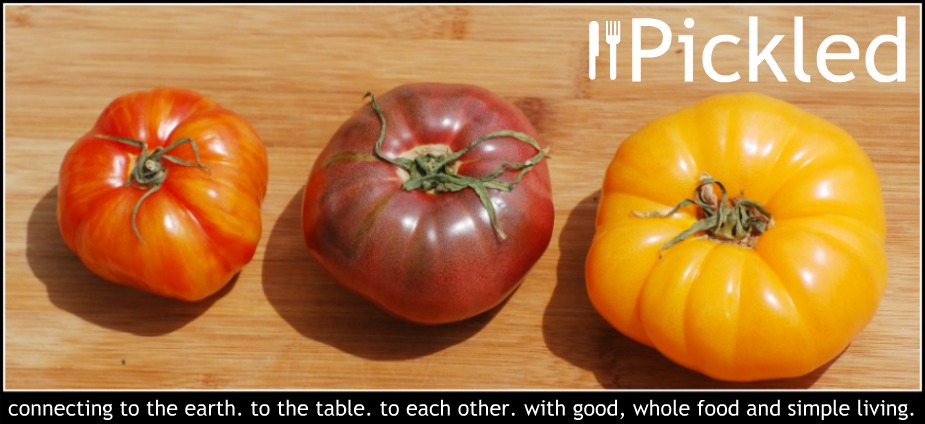“Pomodori fanno pulsare il mio cuore”
That is Italian for “tomatoes make my heart throb.” It’s true. It’s true. When I think of the summer, I long for the day when fresh, heirloom tomatoes are in season. The summer has been practically non-existent here in Seattle so the anticipation for homegrown tomatoes is leaving many tomato lovers weary and wanting --- until today. Finally, a couple of my Dorthy’s Delight heirloom tomatoes have ripened and are ready for harvest. And thank goodness. How much more can one tomato-loving Italian girl take?!
 |
| Still waiting for the others... those are my tears. |
Come on and say it with me, “pomodori fanno pulsare il mio cuore,”… with oomph, animation and while talking with both hands (and throw some hip into while you’re at it).
Doesn’t that make you smile?
 |
| Dorthy's Delight, just picked and sliced |
I’m growing about 5 different types of heirloom tomatoes right now, but you know what captivates me about this particular variety? Dorthy’s Delight is an heirloom seed that has been passed down for 90 years. Isn’t there something special to be said about that? Despite the lack of hot weather that tomatoes need to flourish, still this one fought through. I am in awe when I think of the vital force within this plant, the extraordinary life of these tiny seeds that have been passed down from many generations.
So what does heirloom mean?
 Heirloom and open-pollinated are terms that can be used interchangeably. When these seeds are saved and re-planted, they will return in the same form. You can essentially save the seeds and keep on growing tomatoes without having to buy new seeds every year.
Heirloom and open-pollinated are terms that can be used interchangeably. When these seeds are saved and re-planted, they will return in the same form. You can essentially save the seeds and keep on growing tomatoes without having to buy new seeds every year.If seeds are not heirloom or open-pollinated, they are likely hybrid or genetically-modified. I’m not going to go into this massively controversial topic right now (since I am writing about love and not war), but just know this type of seed doesn’t yield the same form of plant and often dies out after one use; they are genetic dead heads.
Truly, heirloom tomatoes are second to none. In my book, no fruit is more charming or unique than the textures and shades of vibrant color that grace these beautiful summer gifts. They are often bursting at the seams and cracked in unusual places; no one ever really looks like the next. They are perfect.
Some are proudly yellow; some have a mix of lime green stripes with forest green while others are blushing with pink and purple; others have the familiar red, though are still your typical-looking tomato. Heirlooms ooze with personality and beauty. They are meaty and full-flavored. They are worth waiting for. If you don’t grow them, hit up your local farmer’s markets or natural foods markets in the summer.
Some are proudly yellow; some have a mix of lime green stripes with forest green while others are blushing with pink and purple; others have the familiar red, though are still your typical-looking tomato. Heirlooms ooze with personality and beauty. They are meaty and full-flavored. They are worth waiting for. If you don’t grow them, hit up your local farmer’s markets or natural foods markets in the summer.
These tomatoes are not just a pretty face. They are rich in vitamin C and the carotenoid lycopene, especially known for its cancer-fighting properties and anti-oxidant effects which support healthy heart function and protects our cells from oxidative damage. And since carotenoids are fat-soluble, they are better absorbed when eaten with fats (good fats). Between the tomatoes, olive oil and garlic in this dish, well, who knew bruschetta could be so nourishing to the heart?
To read more about the benefits of garlic, click here.
And what better dish to highlight the juicy, fresh taste of tomatoes than bruschetta? I’ve been making bruschetta all summer and the tomatoes have been okay. Made with heirlooms, it’s not just okay; it’s divine. I’m not sure if it’s the wild colors that serenade me, the familiarity and comfort that I associate with garlicky bruschetta or my heartsick condition for these summer treasures. Perhaps all. None the less, I’m delighted to share my version of this simple, traditional recipe with you. Take a bite, close your eyes and savor every bit of bursting flavor that dances in your mouth.
Is it just me or does your heart throb too in the anticipation of summer heirloom tomatoes?
Visit my business website, www.trephowellness.com for the recipe to Heirloom Tomato Bruschetta.
Sources:









